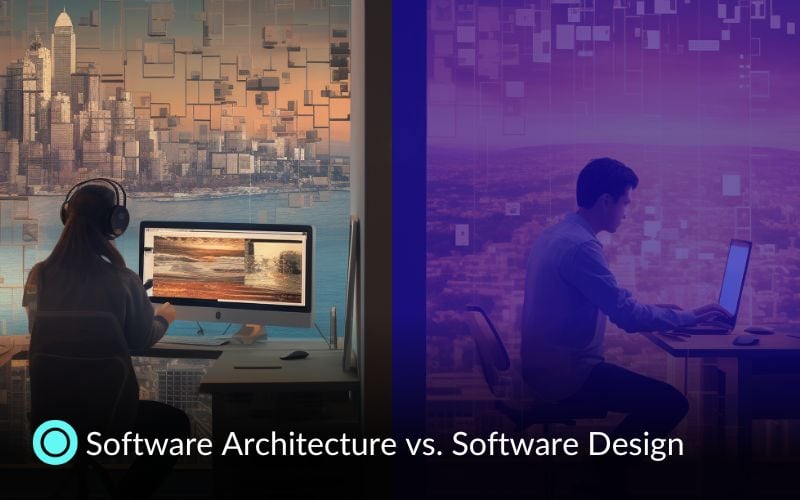Software Architecture vs. Software Design
In the dynamic world of software development, planning and structuring are similar to laying the foundation for a skyscraper. Without a solid base, the entire structure could crumble. This brings us to a pivotal discussion that often puzzles many: the difference between software architecture and software design.
At a glance, architecture vs. software might seem like a debate about bricks versus blueprints. However, when we delve deeper, we realize that understanding the difference between software design and architecture is crucial for the success of any software project. While both terms are frequently used interchangeably, they serve distinct roles in the software development process. Let's embark on a journey to demystify these concepts and shed light on their unique significance.
Definition of Key Terms of Software Architecture and Software Design
When we talk about "software architecture for developers", we're referring to the high-level structuring of software. Think of it as the blueprint for system design, much like an architect's plan for a building. It lays out the big picture, guiding how different parts of a software system will come together.
On the other hand, software design dives into the nitty-gritty. It's all about defining the methods, functions, objects, and how these objects interact with each other. While software architecture management ensures that the blueprint is followed and evolves as needed, software design ensures that every brick (or line of code) fits perfectly in its place.
The Scope of Software Architecture
At its core, software architecture is about painting the big picture. It's like sketching the outline of a grand painting, where the primary focus is on the high-level structure of the software.
This structure isn't just about aesthetics or organization; it's fundamentally about ensuring that the software system will meet the set requirements. It's the roadmap that ensures the software journey heads in the right direction.
Imagine a puzzle. Each piece, unique and distinct, comes together to form a complete image.
In the realm of software architecture, these puzzle pieces are the modules, components, and their interrelationships. These elements are the building blocks of the software, each serving a specific purpose. When assembled correctly, they ensure the software functions as a cohesive unit.
But what good is a structure if it can't stand the test of time and demand? This is where architectural concerns come into play. These concerns revolve around ensuring the software's scalability, so it grows as demands increase.
They focus on performance, ensuring users get a seamless experience. Usability ensures the software remains user-friendly, while resilience guarantees it can weather challenges. And, of course, reuse emphasizes building components that can be utilized in multiple scenarios, maximizing efficiency.
Featured Resource
What does a software architect do?
Delving into Software Design
Software design is where the rubber meets the road. It's the phase where the broad strokes of software architecture transform into detailed plans. Think of it as turning a dream home's blueprint into a tangible, livable space. In software terms, it's about taking those architectural plans and crafting them into operational software, ensuring every feature and function works seamlessly.
Just as a house has bricks, windows, and doors, software design comprises specific elements that make it functional. These are the algorithms that dictate how tasks are executed, the data structures that organize and store information, and the interfaces that ensure different software parts communicate effectively. Each of these components plays a pivotal role in ensuring the software runs smoothly and efficiently.
However, merely having all the parts in place isn't enough. The software design process also addresses several concerns to ensure the software is robust and future-proof.
Modularity ensures that the software is organized into distinct sections for easier management.
Modifiability ensures that future changes can be made without major upheavals. Testability ensures that any issues can be identified and rectified promptly, and maintainability ensures that the software remains in top shape as time goes on, adapting and evolving as needed.
Key Differences Between Software Architecture & Software Design
Imagine looking at a city from an airplane versus walking its streets. From the air, you see the layout, the major landmarks, and how everything connects. This bird's-eye view is similar to software architecture: it's more abstract, giving a high-level perspective of the software's structure.
On the other hand, software design is like being on the ground, observing the details of each building, street, and alley. It's a closer, more detailed look, focusing on the intricacies of how everything works together.
When we talk about the focus of software architecture, it's like discussing the layout of a city: where the parks are, how neighborhoods connect, and the placement of major landmarks. It's all about system components and their relationships.
Software design, in contrast, is more about the implementation. It's like deciding the materials for building a house, the style of windows, or the type of doors. It's the practical side of turning the grand vision into a tangible reality.
Every decision in the software development process carries weight. However, the scope of their impact varies.
Architectural decisions are like city planning choices. Deciding to place a park in a certain location or designating a zone for commercial use can shape the city's future. These decisions affect the overall system.
In contrast, design decisions are more localized, similar to choosing the color of a house or the design of a garden. They often impact specific modules or components, refining the user experience and functionality of particular sections.
Why Both Are Crucial for Successful Software Development
In the dance of software development, the rhythm set by software architecture vs software design is harmonious and intertwined. Just as a tree needs both strong roots (architecture) and healthy leaves (design) to thrive, the software requires the strategic vision of architecture and the detailed precision of design to truly succeed. Their relationship is symbiotic: architecture lays out the grand vision, while design brings this vision to life, ensuring every detail aligns with the overarching plan.
Neglecting either architecture or design is akin to building a house on shaky ground or with weak materials. Without a solid architectural foundation, the software might lack direction and coherence. On the other hand, without meticulous design, even the best architectural plans can falter in execution.
The pitfalls of sidelining one over the other can lead to inefficient software, hard to maintain, or failure to meet user needs. Thus, for a robust and user-friendly software solution, both architecture and design must be given due importance.
Conclusion
In the vast landscape of software development, understanding the distinction between software architecture and design is not just a matter of semantics; it's a cornerstone for success. Just as a chef needs both a recipe and the right cooking techniques, developers need the guiding light of architecture and the precision of design.
By appreciating the unique roles each plays, we pave the way for software that's both visionary and functional. So, as we navigate the intricate world of software creation, let's invest time in both these facets. By doing so, we ensure our software stands tall, robust, and ready to serve
Recommended Further Reading;



